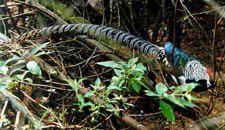Lady Amherst's pheasant
(Chrysolophus amherstiae)
Habitat: forests and bushes in low, middle and high mountain areas.
Feeding habits: peck with bills or scratch on ground surface then peck.
Food: young buds, leaves, flowers, fruits, mushrooms, white ants and locusts.
 Size: the length of male bird is 1.2 m; and female, 60 cm. Weight: 600-800 g. Size: the length of male bird is 1.2 m; and female, 60 cm. Weight: 600-800 g.
Habits:
A kind of resident bird. Normally, golden pheasants act in small groups and hang around in forests. During mating season, male golden pheasants will occupy a piece of land and utter sounds like "ga, ga" to attract female pheasants. After mating, female golden pheasants will build a nest in secret places of the forests to produce eggs and to hatch their young alone. The calls of the bird have many changes and when they communicate with one another, they will utter sounds like "hush, hush"; when they feel dangers, they will utter sounds like "Xiya" to give warning. When mother birds are looking for their young, they will utter sounds like "guo, guo"; while the young birds will utter sounds like "ji, ji".
Lady Amherst's pheasant is distributed in mountain areas of Southwest China and is only seen in Northeast of Burma in foreign countries. Normally, the bird is regarded as endemic specie of China. As early as 170 years ago, the British brought the birds to London. Just the same as golden pheasants, this bird is also one of the most beautiful fancy type pheasants. Zoos and wild zoos in many places are raising lady Amherst's pheasants too.
Category: Ave, Galliformes, Phasianidae
Distribution: most places in Yunnan and mountain areas in Southwest China.
Level of protection: Class II key state protection animal of China
 
|